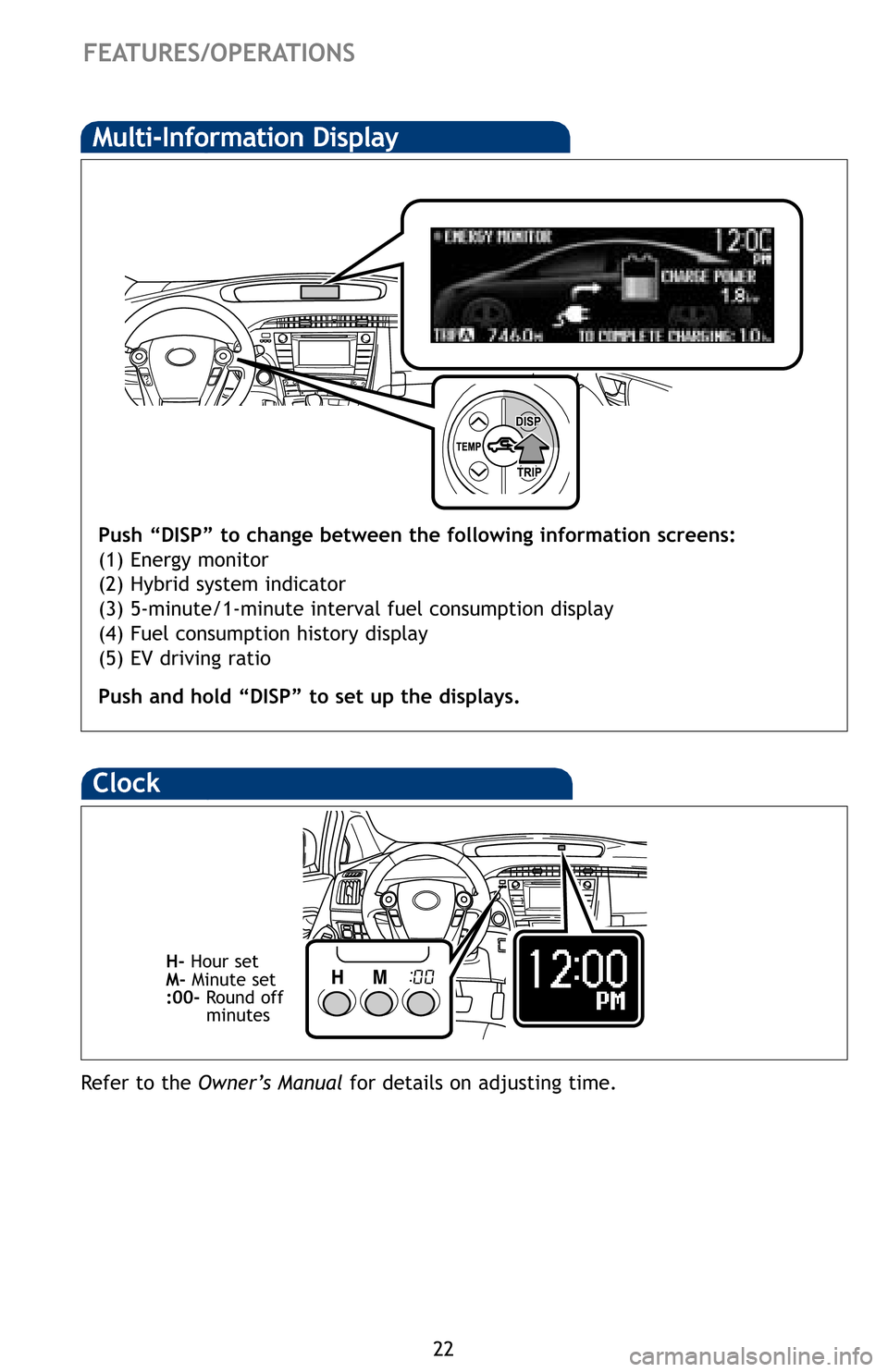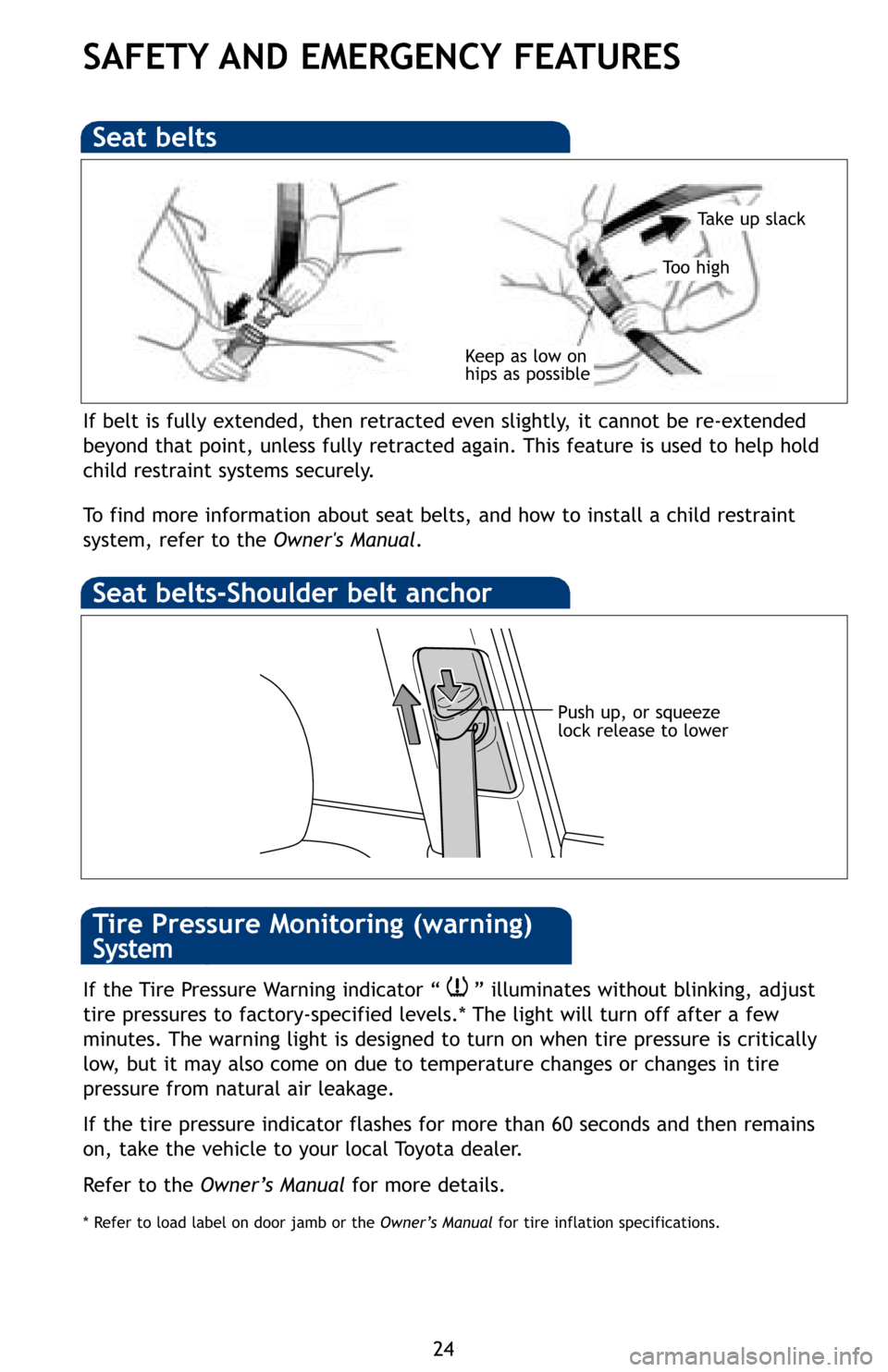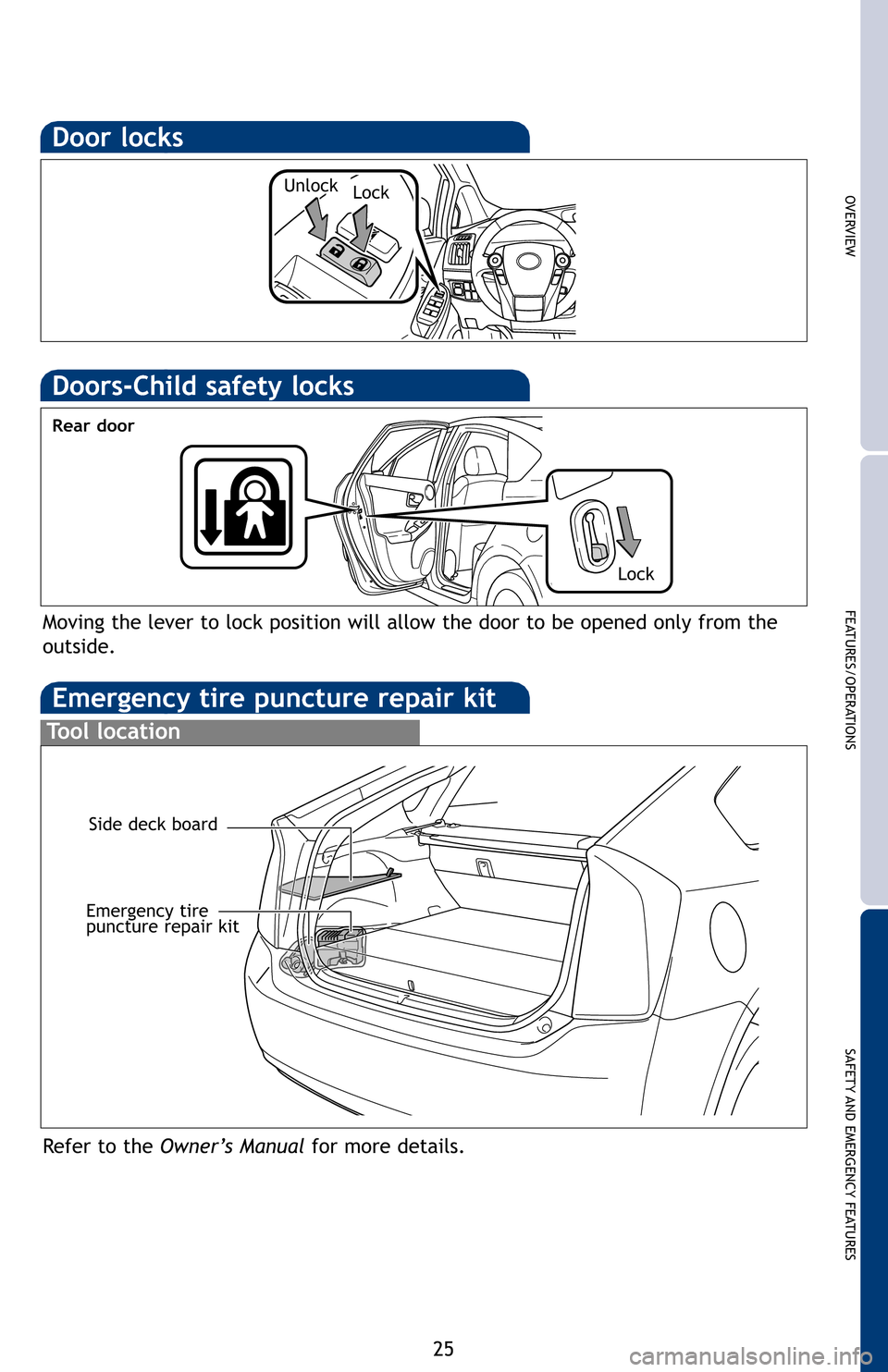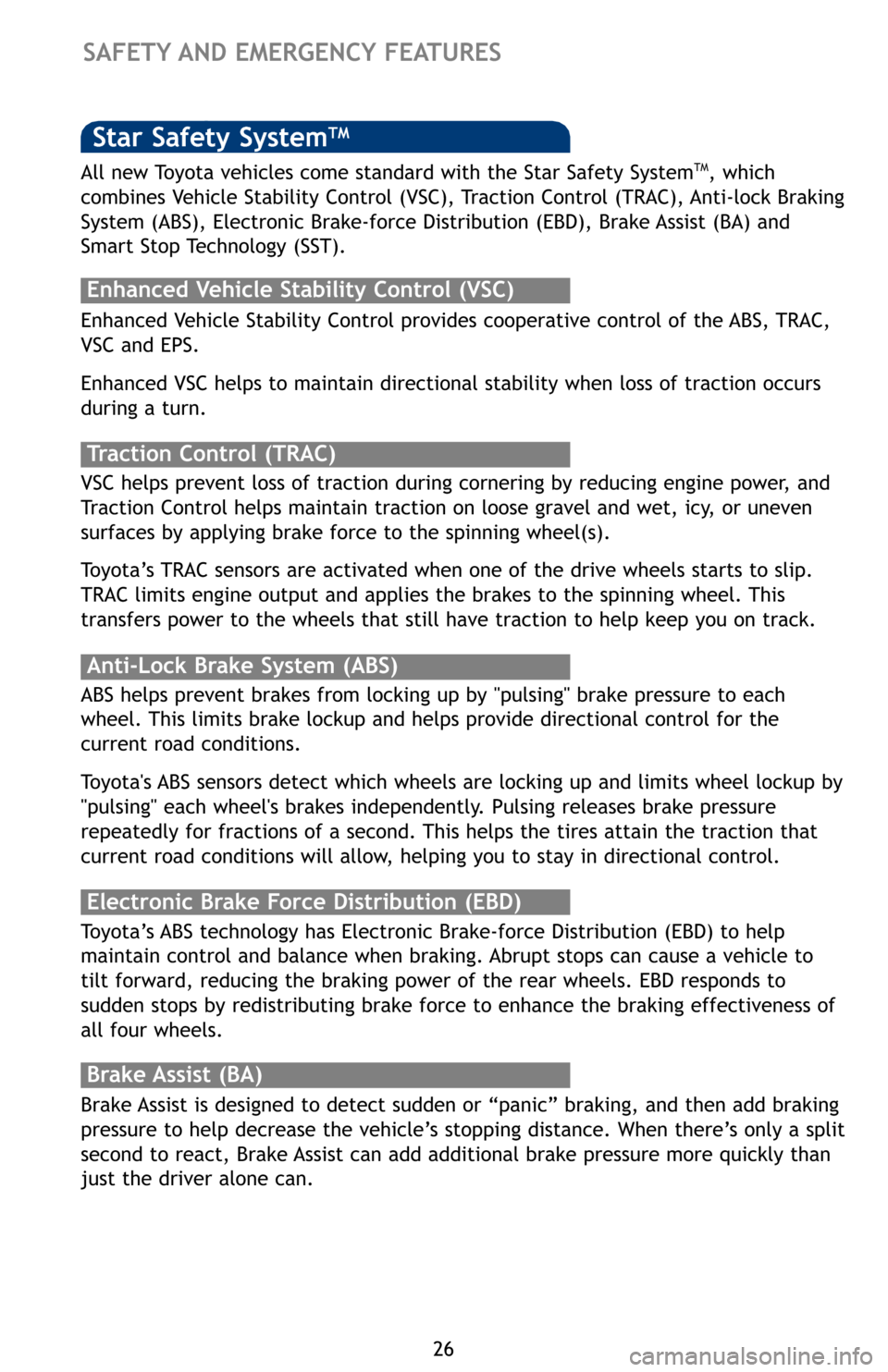lock TOYOTA PRIUS PLUG-IN HYBRID 2012 1.G Quick Reference Guide
[x] Cancel search | Manufacturer: TOYOTA, Model Year: 2012, Model line: PRIUS PLUG-IN HYBRID, Model: TOYOTA PRIUS PLUG-IN HYBRID 2012 1.GPages: 32, PDF Size: 1.84 MB
Page 24 of 32

22
FEATURES/OPERATIONS
Multi-Information Display
Push “DISP” to change between the following information screens:
(1) Energy monitor
(2) Hybrid system indicator
(3) 5-minute/1-minute interval fuel consumption display
(4) Fuel consumption history display
(5) EV driving ratio
Push and hold “DISP” to set up the displays.
Clock
Refer to the Owner’s Manual for details on adjusting time.
H-Hour set
M- Minute set
:00- Round off
minutes
HAC
on b
illum
Refe
Hi
Ga
pro
Ref
det
For
htt
* Ho
Ga
(if
125957_2012-Prius-PHV-QRGnew:2012 2/7/12 2:08 AM Page 22
Page 26 of 32

24
SAFETY AND EMERGENCY FEATURES
If belt is fully extended, then retracted even slightly, it cannot be re-extended
beyond that point, unless fully retracted again. This feature is used to help hold
child restraint systems securely.
To find more information about seat belts, and how to install a child res\
traint
system, refer to the Owner's Manual.
Keep as low on
hips as possible
Take up slack
Too high
Seat belts
Push up, or squeeze
lock release to lower
Seat belts-Shoulder belt anchor
Do
If the Tire Pressure Warning indicator “ ” illuminates without blinking, adjust
tire pressures to factory-specified levels.* The light will turn off after a few
minutes. The warning light is designed to turn on when tire pressure is criticall\
y
low, but it may also come on due to temperature changes or changes in tire
pressure from natural air leakage.
If the tire pressure indicator flashes for more than 60 seconds and then\
remains
on, take the vehicle to your local Toyota dealer.
Refer to the Owner’s Manual for more details.
* Refer to load label on door jamb or the Owner’s Manualfor tire inflation specifications.
Tire Pressure Monitoring (warning)
System
Em
To o
Refe
Movi
outs
Rea
Do
125957_2012-Prius-PHV-QRGnew:2012 2/7/12 3:43 AM Page 24
Page 27 of 32

OVERVIEW
FEATURES/OPERATIONS
SAFETY AND EMERGENCY FEATURES
25
ld
Door locks
t
y
s
Emergency tire puncture repair kit
Tool location
Refer to the Owner’s Manual for more details.
Emergency tire
puncture repair kit
Moving the lever to lock position will allow the door to be opened only \
from the
outside.
Rear door
Doors-Child safety locks
LockUnlock
Side deck board Lock
125957_2012-Prius-PHV-QRGnew:2012 2/7/12 2:08 AM Page 25
Page 28 of 32

26
Star Safety SystemTM
Enhanced Vehicle Stability Control provides cooperative control of the ABS, TRAC,
VSC and EPS.
Enhanced VSC helps to maintain directional stability when loss of tracti\
on occurs
during a turn.
Enhanced Vehicle Stability Control (VSC)
Anti-Lock Brake System (ABS)
Brake Assist (BA)
ABS helps prevent brakes from locking up by "pulsing" brake pressure to \
each
wheel. This limits brake lockup and helps provide directional control for the
current road conditions.
Toyota's ABS sensors detect which wheels are locking up and limits wheel lockup b\
y
"pulsing" each wheel's brakes independently. Pulsing releases brake pressure
repeatedly for fractions of a second. This helps the tires attain the traction that
current road conditions will allow, helping you to stay in directional control.
Brake Assist is designed to detect sudden or “panic” braking, and then a\
dd braking
pressure to help decrease the vehicle’s stopping distance. When there’s only a split
second to react, Brake Assist can add additional brake pressure more quickly than
just the driver alone can. VSC helps prevent loss of traction during cornering by reducing engine p\
ower, and
Traction Control helps maintain traction on loose gravel and wet, icy, or uneven
surfaces by applying brake force to the spinning wheel(s).
Toyota’s TRAC sensors are activated when one of the drive wheels starts to slip.
TRAC limits engine output and applies the brakes to the spinning wheel. \
This
transfers power to the wheels that still have traction to help keep you \
on track.
Traction Control (TRAC)
Electronic Brake Force Distribution (EBD)
Toyota’s ABS technology has Electronic Brake-force Distribution (EBD) to help
maintain control and balance when braking. Abrupt stops can cause a vehicle to
tilt forward, reducing the braking power of the rear wheels. EBD respond\
s to
sudden stops by redistributing brake force to enhance the braking effect\
iveness of
all four wheels.
SAFETY AND EMERGENCY FEATURES
All new Toyota vehicles come standard with the Star Safety SystemTM, which
combines Vehicle Stability Control (VSC), Traction Control (TRAC), Anti-lock Braking
System (ABS), Electronic Brake-force Distribution (EBD), Brake Assist (BA) and
Smart Stop Technology (SST).
Ther
has m
To k e
•O
•Uspl
•In
Flo
Smar
and
SST e
firml
SST d
allow
back
Sma
125957_2012-Prius-PHV-QRGnew:2012 2/7/12 2:08 AM Page 26